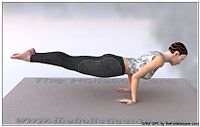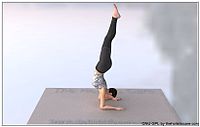- Mayurasana
-
Mayurasana (Sanskrit: मयूरासन) or Peacock Pose[1] is an asana.
Contents
Etymology
The name comes from the Sanskrit words mayura (मयूर) meaning "peacock"[2] and asana (आसन) meaning "posture" or "seat".[3]
Description
In this yoga posture oneself is raised like a horizontal stick holding the floor with both the palms with the support of elbows.
Cautions
Mayurasana is a very important balancing pose but this demands good physical strength. In this posture entire weight of the body remains on navel and it is possible to lose the balance at any moment, so needs special care. Those suffering from cervical spondylitis are not recommended to practice it.
Variations
Pincha Mayurasana (पिन्च मयूरासन)[4] (Feathered Peacock Pose)[5]
Padma Mayurasana (Lotus Peacock Pose)[6]
Uttana Padma Mayurasana (Intense Stretch Lotus Peacock Pose)[7]
See also
- List of Hatha yoga postures
References
- ^ "Yoga Journal - Peacock Pose". http://www.yogajournal.com/poses/2495. Retrieved 2011-04-09.
- ^ "Mayurasana - AshtangaYoga.info". http://www.ashtangayoga.info/practice/asana-vinyasa-series/intermediate-series-nadi-shodhana/item/mayurasana/. Retrieved 2011-04-09.
- ^ Sinha, S.C. (1 June 1996). Dictionary of Philosophy. Anmol Publications PVT. LTD.. p. 18. ISBN 9788170412939. http://books.google.com/books?id=-zzRvh1fRzEC&pg=PA18. Retrieved 9 April 2011.
- ^ "Pincha Mayurasana - AshtangaYoga.info". http://www.ashtangayoga.info/practice/asana-vinyasa-series/intermediate-series-nadi-shodhana/item/pincha-mayurasana/. Retrieved 2011-04-09.
- ^ "Yoga Journal - Feathered Peacock Pose". http://www.yogajournal.com/poses/1711. Retrieved 2011-04-09.
- ^ Ramaswami, Srivatsa; Krishnamacharya, T. (3 June 2005). The complete book of vinyasa yoga: an authoritative presentation, based on 30 years of direct study under the legendary yoga teacher Krishnamacharya. Da Capo Press. p. 208. ISBN 9781569244029. http://books.google.com/books?id=4lxjoht7W8oC&pg=PA208. Retrieved 9 April 2011.
- ^ "Uttana Padma Mayurasana". http://www.yogaartandscience.com/poses/inver/upmayura/upmayura.html. Retrieved 2011-04-09.
Further reading
- Iyengar, B. K. S. (1 October 2005). Illustrated Light On Yoga. HarperCollins. ISBN 9788172236069. http://books.google.com/books?id=pbx5AAAACAAJ. Retrieved 9 April 2011.
- Saraswati, Swami Satyananda (1 August 2003). Asana Pranayama Mudra Bandha. Nesma Books India. ISBN 9788186336144. http://books.google.com/books?id=YpR1QgAACAAJ. Retrieved 9 April 2011.
- Saraswati, Swami Satyananda (January 2004). A Systematic Course in the Ancient Tantric Techniques of Yoga and Kriya. Nesma Books India. ISBN 9788185787084. http://books.google.com/books?id=eWOrAAAACAAJ. Retrieved 9 April 2011.
External links
Asanas Adho Mukha Svanasana · Anantasana · Ardha Candrasana · Ardha Matsyendrasana · Ardha Navasana · Baddha Konasana · Bakasana · Balasana · Bhujangasana · Chakrasana · Chaturanga Dandasana · Dandasana · Dhanurasana · Garbhasana · Garudasana · Gomukhasana · Halasana · Hanumanasana · Hasta Uttanasana · Janusirsasana · Kakasana · Kapotasana · Kukutasana · Kurmasana · Makarasana · Malasana · Matsyasana · Mayurasana · Natarajasana · Padahastasana · Padmasana · Paripurna Navasana · Parivrtta trikonasana · Paschimottanasana · Pashasana · Pavanamuktasana · Salabhasana · Sarvangasana · Savasana · Siddhasana · Simhasana · Sirsasana · Sukhasana · Supta Virasana · Tadasana · Trikonasana · Tulasana · Urdhva Hastasana · Urdhva Dhanurasana · Ustrasana · Utkatasana · Uttana Shishosana · Uttanasana · Uttanapadasana · Utthita Trikonasana · Vajrasana · Virasana · VriksasanaRelated Yoga Raja Yoga Yoga Sutras of Patanjali · Eight Limbs: (1) Yama (2) Niyama (3) Āsana (4) Pranayama (5) Pratyahara (6) Dhāraṇā (7) Dhyāna (8) SamādhiHatha Yoga Hindu views on monotheism
and reform movementsThree Yogas (Karma, Bhakti, Jñāna) · Kriya Yoga · Kundalini yoga · Satyananda Yoga · other styles and schools
This health-related article is a stub. You can help Wikipedia by expanding it. This spirituality-related article is a stub. You can help Wikipedia by expanding it.


